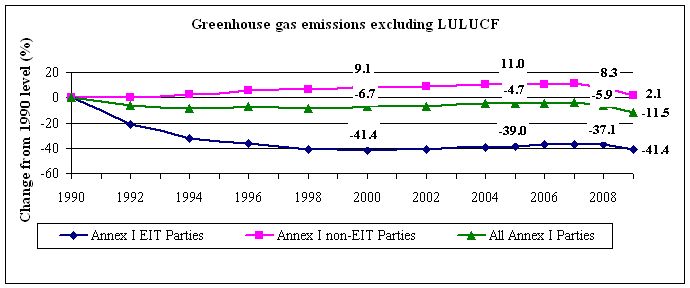Well, in about a month (to be precise: the 28th of November to the 9th of December), the 17th Conference of the Parties (COP-17) of the UN Framework Convention on Climate Change (UNFCCC) will meet in Durban, South Africa. One of the major issues confronting COP-17 is the fact that the Kyoto Protocol “expires” in December 2012, and the international society still does not have a binding agreement for any emissions cuts after that time.
This has been portrayed in cataclysmic terms: for one example, the UK Guardian indicated that it would be the “death knell” for the climate fight. The implication is that, without a binding agreement on whether, what and how to cut emissions, governments around the world would lose any incentive to curb the six main greenhouse gases (GHGs), plunging us into a world in which states burned oil and coal with abandon, razed the forests, accumulating GHGs in the atmosphere at exponentially increasing rates.
But I’m not convinced this view is correct. In the first place, it’s pretty far from clear that the Kyoto Protocol – as an institution – has contributed meaningfully to international governance. In the first place, the major GHG emitters, the US and China, are not bound by the Kyoto Protocol, and there is no reason to assume that any subsequent agreement would include them anyway (especially if, as is one suggestion, the post-2012 era is characterized by an extension of the current Protocol).
Second, and related, the effort to create in 1997 an agreement that would incorporate the political interests of post-Soviet, western European, and North American states led to an institution that was barely better than the lowest-common-denominator. One datum I find interesting is that, technically speaking, the goals of the Kyoto Protocol – a cut in GHG emissions among Annex I Countries of 5.2% below 1990 levels – have been met. However, as the figure below indicates, this goal has been met largely through the activities of Economies In Transition (read: post-Soviet) countries, most of which helpfully had a collapse in economy and industry immediately after 1990. Meanwhile, overall GHGs have increased substantially since then, and the goal was so modest as to be laughable (the IPCC had originally recommended a 60% cut). Would a new protocol be any more meaningful?

GHG Emissions for Annex I Countries
Third, and perhaps more encouraging, there is some evidence that countries are taking unilateral action to curb GHG emissions in more ambitious ways than are currently conceivable under the KP and the UNFCCC. Most encouragingly, the EU launched in 2008 a plan called the EU 20 20 20. Briefly, this consists of a pledge by the Union to cut GHG emissions by 20%, increase the proportion of renewable energy to 20% of overall energy, and cut energy consumption by 20%, all by 2020. Ambitious, sure, but in 2011, the region had cut GHG emissions from 1990 levels by 15.5%.
So what does this mean? Well, the failure of the UNFCCC COP-17 to negotiate a binding agreement post 2012 will not necessarily mean that countries will do any worse than they are now. More significantly, a new agreement post 2012 does not mean that they will do any better. Concern about the presence or absence of a likely meaningless international institution could probably be better spent elsewhere – say, focusing on generating domestic political will to adopt as significant regulations as the EU. Without domestic support in the major contributing states, international institutions will be empty, and the hand-wringing over the second commitment period a waste of time.